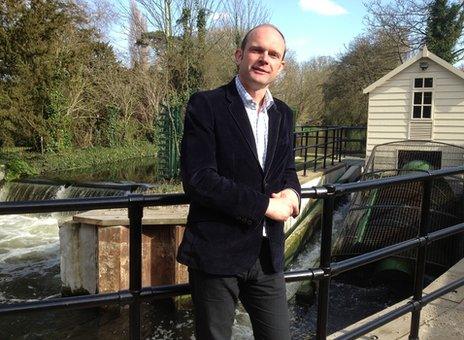Conservation group to get 50% of energy from renewables
- Published
- comments

The Trust already has some 150 individual renewables schemes
The National Trust has revealed a plan to generate half of its power from renewable sources by 2020.
The trust already has 150 individual renewables schemes, but the new document projects how fossil fuel will be reduced across its properties.
It aspires to set an example to others by integrating renewable energy into sensitive landscapes.
The organisation has been criticised for its chairman's vociferous campaign against wind power.
This is considered as the renewable source with most potential in the UK.
Under its new plan, the trust's main renewables by 2020 will be hydro (27%) and biomass (21%); augmented by heat pumps (1%) and solar (0.5%).
Grid electricity will supply 26% of its power, gas 15% and LPG 6%. Oil - currently a major cost and carbon source for the trust's rural properties - will be reduced to just 3%.
There are also plans to cut energy consumption by 20%. Wind power will play no part, because the trust's historic landscapes are deemed too sensitive.
Patrick Begg, rural enterprise director for the trust, which aims to preserve historic buildings and land for the enjoyment of the public, told BBC News: "We've put all our effort to make the big leap in generating renewable energy from all our properties. Our new programme will get us to (50% of energy) by 2020."
The subsidised renewables will save the organisation money, he said, producing an expected return on capital of 10% - much better than traditional investments.
Unexpected bonus
Morden Hall Park, external, in south-west London, already boasts an array of renewables, including a wood-fired boiler, different sorts of solar panels and what is claimed to be the UK's most energy-efficient historic building, the Stable Yard.
The new showpiece, behind the old water wheel and Snuff Mill, is an Archimedes screw, external reclining in the River Wandle, lazily generating power for the visitor centre (the Archimedes screw was originally designed as an irrigation pump. Its modern adaptation allows power to be generated from a low head of water).
The biggest unexpected bonus to the trust overall has come from biomass burning for heating. The organisation owns 25,000 hectares of woodland and Mr Begg acknowledged initial fears that wildlife would be harmed if the woods were managed more intensively for fuel.

Here, Patrick Begg stands in front of the Archimedes Screw on the River Wandle
"We were very pleased to see that the opposite has been the case," he said. "Managing woods more intensively, including coppicing, has actually increased biodiversity."
The trust's efforts overall have been applauded - but with reservations. It is a major land-holder, but if all the improvements go to plan will still be generating the tiniest fraction of the UK's renewable energy.
What is more, its chairman Simon Jenkins has used his influential newspaper columns to fuel opposition to wind energy, which is the most readily available large-scale renewable energy source in the UK.
This has been highly controversial with some environmentalists accusing him of setting back the cause of renewable energy in a desire to preserve the landscape in aspic.
Mr Begg said: "Simon has some very strong opinions about wind, which he's free to express. The Trust has been perfectly clear - we're not anti-wind, we're anti-wind in the wrong place, badly designed."
He said the Trust, an organisation loved by Britain's middle classes, had no misgivings about receiving electricity subsidies from poor people struggling to pay their bills. The subsidy system, he said, was designed to tackle climate change and the Trust wished to play its part.
The majority of the trust's estate was free to enter, he said There were no plans to open the other properties free of charge to people in fuel poverty.
Follow Roger on Twitter, external
- Published27 February 2013